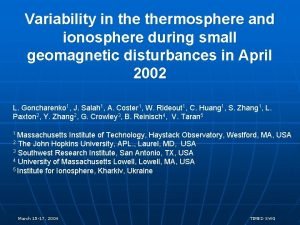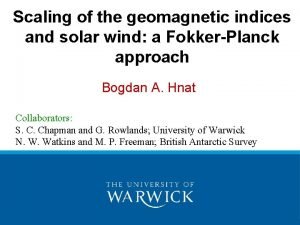Geomagnetic activity indicates large amplitude for sunspot cycle

- Slides: 1

Geomagnetic activity indicates large amplitude for sunspot cycle 24 David H. Hathaway & Robert M. Wilson NASA/National Space Science & Technology Center, Huntsville, AL Introduction ABSTRACT Solar activity impacts our technological assets in space and on the ground and can be a hazard for space travelers. Predicting the level of solar activity years in advance is particularly important for those who operate satellites, communication systems, and even airlines and electrical power distribution systems. The level of geomagnetic activity near the time of solar activity minimum has been shown to be a reliable indicator for the amplitude of the following solar activity maximum. The geomagnetic activity index IHV can be split into two components: one associated with solar flares, prominence eruptions, and coronal mass ejections which follows the solar activity cycle and a second component associated with recurrent high speed solar wind streams which is out of phase with the solar activity cycle. This second component often peaks before solar activity minimum and has been one of the most reliable indicators for the amplitude of the following maximum. The size of the recent maximum in this second component indicates that solar activity cycle 24 will be much higher than average – similar in size to cycles 21 and 22 with a peak smoothed sunspot number of 160± 30 (Hathaway & Wilson 2006). Sunspot Cycle Predictions Given two parameters characterizing a sunspot cycle – its amplitude and starting time – the level of activity throughout the cycle can be well predicted (Hathaway, Wilson, & Reichmann 1994). Both of these parameters are well determined by the level of activity itself 2 to 3 years after the cycle starts. The more difficult task is to determine these parameters at, or before, the start of the cycle. We determine the basal level due to the solar activity component by fitting a straight line through the bottom-most values of the annual geomagnetic IHV index in 20 bins of annual sunspot number values (0 -10, 10 -20, … 190 -200). This is shown by the red line in Figure 3. Figure 1. Predictions (smooth black lines) for the last three solar cycles using amplitude and starting times determined 30 -months after the start of each cycle. Monthly averages of the observed daily sunspot numbers are shown by the jagged red lines. Testing the Prediction Method We test this method by backing up in time, calibrating it using data prior to that time, and then predicting future cycle amplitudes for cycles 19 -23. The results, shown in Figure 6, have an RMS error of only 17! Geomagnetic Precursor Prediction Method A number of methods have been proposed for predicting the amplitude of a cycle at, or before, the start of the cycle. We have tested many of these methods by backing up in time, calibrating each method using data prior to that time, and then predicting future cycle amplitudes using each method (Hathaway, Wilson, & Reichmann 1999). We found that three methods (all using indices of geomagnetic activity) outperform all others. Of these three methods, one (based on the work of Feynman (1982) and using the geomagnetic aa index) can provide a prediction well before the cycle starts. Figure 5. The amplitudes of the solar activity cycles as functions of the size of the peak in IHVI prior to minimum. The two quantities are correlated at the 94% level and the correlation is significant at the 99. 9% level. The 2 -sigma error intervals are shown by the dotted lines. This relationship, along with the peak value of 19. 5 for IHVI back in 2003, indicates an amplitude of 160 ± 30 for cycle 24. This is similar to the amplitudes of cycles 21 and 22. Figure 3. Annual values for the smoothed geomagnetic IHV index versus annual values for the smoothed sunspot number R. The solar activity component of geomagnetic activity (IHVR) is determined by finding the best fit for a straight line through the lowest values of geomagnetic activity as a function of R. Figure 6. Predictions based on earlier data for cycles 19 to 23 along with the current prediction for cycle 24. The predictions are shown in red with 2 -sigma error bars. CONCLUSIONS Figure 2. Smoothed (with a 24 -month FWHM Gaussian) Geomagnetic indices aa and IHV versus time. These indices are derived from magnetometer data taken at two anti-podal stations after 1868. The IHV (Inter-Hour Variability) index has incorporated corrections for changes in the locations of these instruments (Svalgaard, Cliver, & Le. Sager 2004). Feynman (1982) suggested that there are two components to geomagnetic activity. She observed that geomagnetic activity has a basal level which increases with sunspot number (Figure 3). She identifies this basal level as a solar activity component of geomagnetic variability. This component is proportional to the sunspot number and is associated with solar flares, prominence eruptions and coronal mass ejections. She identifies the remaining variability as an “interplanetary” component associated with coronal holes and recurrent highspeed solar wind streams. Geomagnetic activity in the years prior to solar cycle minimum provides a reliable estimate for the amplitude of the following cycle. The peak in this “interplanetary” component of geomagnetic activity usually occurs 2 -3 years before minimum. The peak in this component of geomagnetic activity in late 2003 indicates that cycle 24 will be comparable in size to cycles 21 and 22 with a maximum sunspot number of 160± 30. Figure 4. The two components of the smoothed geomagnetic IHV index. The solar activity component (IHVR) is proportional to the sunspot number and directly reflects the solar activity cycle. The interplanetary component (IHVI) is the remaining signal. The peaks in IHVI (defined in Figure 4) occur before solar activity minimum and can be seen to foreshadow the peaks in solar activity for the next cycle! This is the signal for the predictive capability of the geomagnetic indices. In Figure 5 we compare the amplitudes of the peaks in IHVI to the peaks in the sunspot numbers for the next cycle and find that they are significantly correlated. REFERENCES Feynman, J. , “Geomagnetic and solar wind cycles, 1900 -1975. ” J. Geophys. Res. 87(A 8), 6153 -6162, 1982. Hathaway, D. H. & Wilson, R. M. , “Geomagnetic activity indicates large amplitude for sunspot cycle 24, ” Geophys. Res. Lett. 33 L 18101, 2006. Hathaway, D. H. , Wilson, R. M. , & Reichmann, E. J. , “The Shape of the Sunspot Cycle, ” Solar Phys. 151, 177 -190, 1994. Hathaway, D. H. , Wilson, R. M. , & Reichmann, E. J. , “A synthesis of solar cycle prediction techniques, ” J. Geophys. Res. 104(A 10), 22, 375 -22, 388, 1999. Svalgaard, L. , Cliver, E. W. , & Le Sager, P. , “IHV: a new long-term geomagnetic index. ” Adv. Space Res. 34, 436 -439, 2004.

